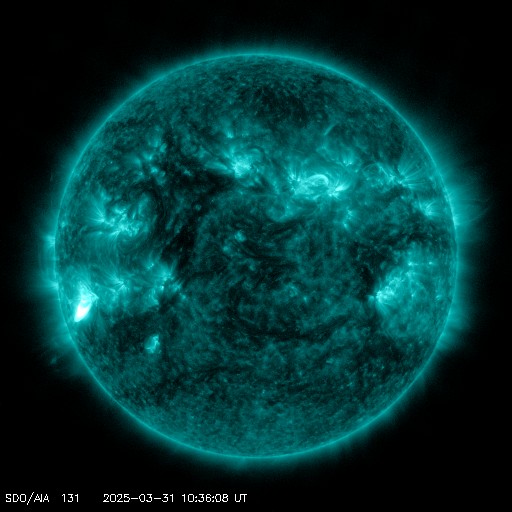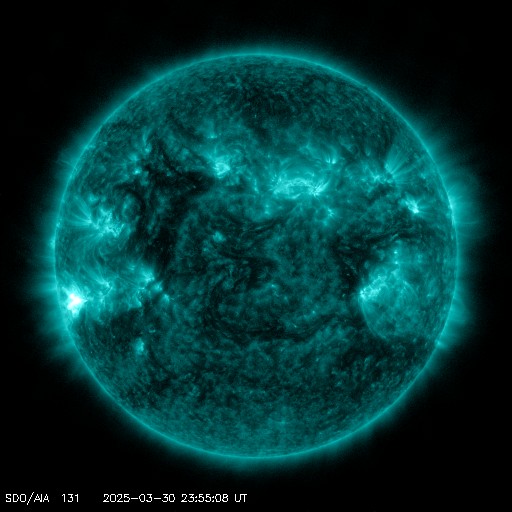Viewing archive of Friday, 28 October 2011
Solar activity report
Any mentioned solar flare in this report has a scaling factor applied by the Space Weather Prediction Center (SWPC). Because of the SWPC scaling factor, solar flares are reported as 42% smaller than for the science quality data. The scaling factor has been removed from our archived solar flare data to reflect the true physical units.
Report of Solar-Geophysical Activity 2011 Oct 28 2200 UTCPrepared by the NOAA © SWPC and processed by SpaceWeatherLive.com
Joint USAF/NOAA Report of Solar and Geophysical Activity
SDF Number 301 Issued at 2200Z on 28 Oct 2011IA. Analysis of Solar Active Regions and Activity from 27-2100Z to 28-2100Z
Solar activity was low. Three C-flares occurred during
the past 24 hours, one from Region 1333 (N15W02) and two from Region
1324 (N13W63). Region 1324 showed emergence of new flux during the
past 24 hours. Region 1333s growth has slowed considerably and the
region is currently a small D-type sunspot group with about 50
millionths in sunspot area. Region 1330 (N08W09) continues to be the
largest group on the disk with about 450 millionths area and a
beta-gamma magnetic classification, but did not produce any flares.
A CME was noted from the northeast limb entering the LASCO C3 field
of view around 1254Z on the 27th and was associated with a filament
eruption and post eruptive loop arcade in the northeast quadrant.
The CME appears to be moving too far north of the ecliptic to be
geoeffective. An additional CME was observed off the southwest limb
and entered the C3 field of view at 0218Z on the 28th. STEREO
coronagraph observations clearly showed that this was a backsided
event and therefore the event is not expected to be geoeffective.
IB. Solar Activity Forecast
Solar activity is expected to be low.
There is a slight chance for an isolated M-class event with Regions
1330, 1324, and 1333 the most likely sources.
IIA. Geophysical Activity Summary 27-2100Z to 28-2100Z
The geomagnetic field was quiet.
IIB. Geophysical Activity Forecast
The geomagnetic field is
expected to be quiet for the first part of day one (29 October). An
increase to unsettled levels with a chance for active periods is
expected beginning late on the 29th and continuing through the first
and second days (30-31 October). The increase is expected due to a
high speed stream from coronal hole.
III. Event Probabilities 29 Oct to 31 Oct
| Class M | 15% | 15% | 15% |
| Class X | 01% | 01% | 01% |
| Proton | 01% | 01% | 01% |
| PCAF | Green | ||
IV. Penticton 10.7 cm Flux
Observed 28 Oct 134 Predicted 29 Oct-31 Oct 135/135/130 90 Day Mean 28 Oct 124
V. Geomagnetic A Indices
Observed Afr/Ap 27 Oct 004/004 Estimated Afr/Ap 28 Oct 003/003 Predicted Afr/Ap 29 Oct-31 Oct 007/008-010/010-010/010
VI. Geomagnetic Activity Probabilities 29 Oct to 31 Oct
| A. Middle Latitudes | |||
|---|---|---|---|
| Active | 10% | 25% | 25% |
| Minor storm | 05% | 15% | 15% |
| Major-severe storm | 01% | 05% | 05% |
| B. High Latitudes | |||
|---|---|---|---|
| Active | 15% | 35% | 35% |
| Minor storm | 05% | 25% | 25% |
| Major-severe storm | 01% | 15% | 15% |
All times in UTC
Current data suggests there is a slight possibility for aurora to appear at the following high latitude regions in the near future
Whitehorse, YTAnchorage, AK, Fairbanks, AK, Juneau, AK, Utqiagvik, AK
Latest news
Latest forum messages
AR4046 136AR4048 35Solar Demon 3Unspecified geomagnetic activity 2146Aurora photography hints for those of us with smartphones 54
More topicsSupport SpaceWeatherLive.com!
A lot of people come to SpaceWeatherLive to follow the Sun's activity or if there is aurora to be seen, but with more traffic comes higher server costs. Consider a donation if you enjoy SpaceWeatherLive so we can keep the website online!

Latest alerts
11:15 UTC - Solar protons
Minor S1 Solar Radiation Storm - Minor impacts on HF radio through polar regions
10:45 UTC - Solar flare
Moderate M1.26 flare
10:27 UTC - Radio Blackout
Minor R1 radio blackout in progress (≥M1 - current: M1.22)
00:09 UTC - Solar flare
Moderate M1.03 flare
Sunday, 30 March 2025
23:51 UTC - Radio Blackout
Minor R1 radio blackout in progress (≥M1 - current: M1.03)
Space weather facts
| Last X-flare | 2025/03/28 | X1.1 |
| Last M-flare | 2025/03/30 | M1.0 |
| Last geomagnetic storm | 2025/03/27 | Kp5 (G1) |
| Spotless days | |
|---|---|
| Last spotless day | 2022/06/08 |
| Monthly mean Sunspot Number | |
|---|---|
| February 2025 | 154.6 +17.6 |
| March 2025 | 127 -27.6 |
| Last 30 days | 127 -25.7 |




